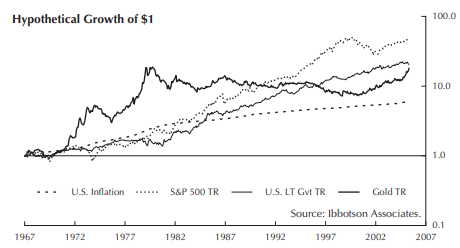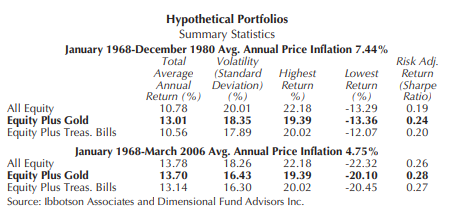Gold has been rediscovered by the financial press. Ignored and even scorned during the “tech boom” of the late 1990s, it is suddenly a glamour asset. In our view, gold is one of many asset classes worthy of inclusion in most portfolios. While many view gold as a commodity, our parent, the American Institute for Economic Research, has long held that gold is a form of money, and the only one that has maintained its purchasing power throughout history.
It is valuable to investors as a form of insurance. Since gold was allowed to “float” in 1968, its record as an inflation hedge has been mixed. The chart below depicts the hypothetical growth of one dollar invested in several asset classes beginning in January 1968 (the earliest date that common data was available). Through the late 1970s when price inflation was rapidly accelerating, gold was virtually the only asset class that protected investors’ purchasing power. However, between 1980 and 2001, a period of slow but steady price inflation, common stocks and even long term bonds provided far stronger inflation-adjusted returns than gold.
The chart also belies the notion that gold is a “conservative” investment. Over the entire period, gold was far more volatile (standard deviation of 22.3) than the S&P 500 (standard deviation 16.9) and long-term bonds (standard deviation 11.3).

So why hold gold? The tables on the next page compare the hypothetical performance of three portfolios during different time periods. The first is an “all equity” portfolio invested equally in the S&P 500, the Fama-French Large Value portfolio, and the Fama-French Small Value portfolio. The second portfolio invests 30 percent in each of these equity indexes and devotes 10 percent to gold. The third portfolio invests 30 percent in each equity index and 10 percent in 30-day U.S. Treasury bills.
Between 1968 and 2000, a period of extreme price inflation and stress in the financial markets, the gold portfolio provided vastly superior absolute and risk-adjusted returns (as measured by the Sharpe ratio), than either the all-equity portfolio or the Treasury portfolio. Over the longer term, through March 2006, after inflation subsided and the economy recovered, the “uninsured” all-equity portfolio provided the highest overall returns, but only barely, and failed to match the risk-adjusted returns of the gold portfolio.

Investors should hold gold only in limited amounts, and for the right reasons, not because of the recent attention it has garnered. Gold has historically provided insurance during periods of extreme price inflation and financial stress, and its price has been negatively or very weakly correlated with other asset classes. We will continue to recommend it as long as it continues to demonstrate these properties.
Also in This Issue:
When to Begin Receiving Social Security Payments
The Tax Increase Prevention and Reconciliation Act of 2005 (TIPRA)
The ABCs of Mutual Fund Share Classes: Know What You’re Buying
The High-Yield Dow Investment Strategy
Recent Market Statistics
The Dow-Jones Industrials Ranked by Yield
Asset Class Investment Vehicles
To access the full article, please login or subscribe below.
Already a Subscriber?
Log in now
Subscribe Today
Get full access to the Investment Guide Monthly.
Print + Digital Subscription – $59/YearIncludes 12 Print and Digital Issues
Print + Digital Subscription – $108/2 Years
Includes 24 Print and Digital Issues
Digital Subscription – $49/Year
Includes 12 Issues
Digital Subscription – $98/2 Years
Includes 24 Issues

